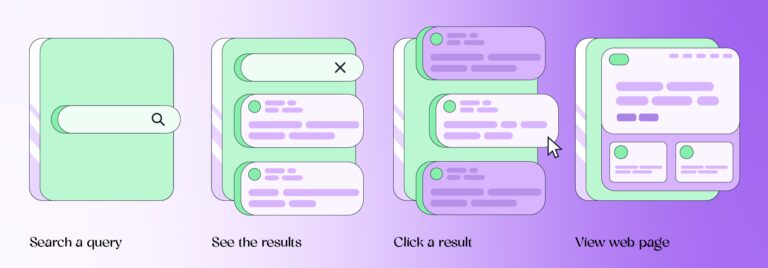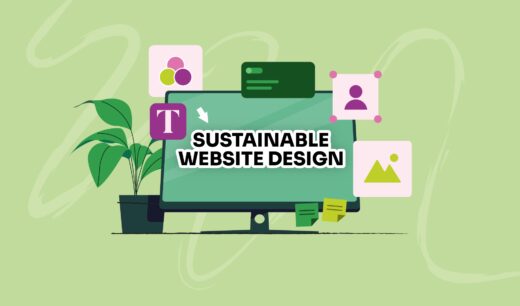How to practice green SEO
6 min read

What is green SEO and how can you make a change by practising it?
Whilst it’s not always possible to make substantial impacts toward digital sustainability with design and development, more sustainable SEO is always an action we can take to support lowering website carbon emissions
As a B Corp and web design agency, we’re committed to reducing Abstrakt’s and our clients’ carbon footprints and supporting, informing, and educating more businesses about their impact and how to become more carbon-conscious about their digital presence. Businesses are increasingly aware of their environmental impact and as companies adopt greener practices in their physical operations, they are now exploring ways to make their digital presence more sustainable too.
Enter green SEO... an emerging practice that focuses on reducing the amount of (frustrated!) clicks to and off of a website by maintaining strong search engine rankings based on user intent.
What is green SEO?
Green SEO refers to the practice of optimising websites for search engines in a way that minimises environmental impact. The focus of traditional SEO is improving rankings and driving organic traffic through technical, on-page, and off-page strategies.
However, Green SEO emphasises creating an efficient, fast, and eco-friendly website experience that reduces the carbon footprint while maintaining visibility and performance.
Every action on the web — whether browsing, clicking, or streaming — consumes energy. Websites with heavy data loads, slow load times, or inefficient hosting practices contribute to higher energy consumption, and, therefore, a larger carbon footprint.
Green SEO strives to reduce this impact by focusing on sustainable SEO strategies and helpful, relevant content that keeps a user from returning to search and clicking more results or searching different queries. It’s targeting user intent.
How to practice green SEO
Making on-page SEO more sustainable
Content culls
When I start a website project, I’ll crawl a site with Screaming Frog which gives me a lot of information from the outset: the number of pages, URLs (and sitemap structure), metadata, Page speeds, response codes, canonicals, etc. I’ll combine that data with Google Search Console and GA4 data so I have everything I need to see, analyse and understand, in one sheet.
That’s when I can begin to cull content, by which I mean, identify content which doesn’t perform or support users (and, therefore, support search).
When I’m doing this, some of the metrics I look at:
All traffic page views vs new and returning users
Organic landing page sessions vs users
Average engagement time per page
Onward journeys (path exploration (GA4))
What I’m trying to understand is, the amount of users visiting a page (new and returning) compared to the time they’re spending on it, and if they’re continuing onto the desired call-to-action, engaging with the information but exiting, or simply dropping off.
A good amount of time on page + desired call-to-action = the content is relevant and useful
A good amount of time on page + exiting = the content is useful and they’re on a journey of discovery
Little time on page + exit = the content doesn’t meet their search intent (or the annoying one, they’re a bot!)
That decides what content stays or goes or if pages need tweaking to better meet user intent.
If a user stays on the site, they’re not using more energy and creating further carbon emissions to return to their search engine, and start a new query or load another website.
User intent
We dive much deeper into what user intent is in our article about SEO and SXO user intent, however, user intent is incredibly powerful for green SEO practices.
User intent, often referred to as search intent, represents the goal or purpose behind a user’s search query. It’s what the user hopes to accomplish when they type something into a search engine or ask their virtual assistant (think Siri or Google Assistant).
By strategically considering SEO strategies with user intent at the forefront, it’s possible to map keywords based on intent at the page level and ensure the content matches the same user intent.
Why is this important? It ensures that a page is built, written and optimised for that intent so when a user searches a query and a webpage is served in SERPs when they click on the page, they’re more likely to find their answer and not have to do more searches or click more sites to get the answering and understanding they’ve been looking for.

Keyword mapping
Keyword mapping is an important part of any SEO strategy and we must ensure we’re not keyword stuffing or adding keywords to a page that aren’t relevant (or don’t match user intent). Correct keywords ensure Google and other search engines share a page based on its relevancy to a query and won’t leave the user frustrated when they arrive on a page that doesn’t meet their intent.
Information architecture / URL structure
As search engines become more intelligent and understand NLP (the language and types of words people use and understand), it’s becoming more important for websites to be structured for users and search. That’s where search experience optimisation comes in, where a UX designer and an SEO work hand-in-hand to optimise a site for user and search.
SXO works to consider a site’s sitemap and architecture to correctly pocket/categorise content and pages on a site which makes it far more intuitive for audiences and easy to understand what the overall site is about for search engines, which, once again, means better visibility in SERPs and users who’re less likely to drop-off.
Content creation
The type of content you create and how you deliver it can also contribute to sustainable SEO practices. Green content creation focuses on delivering value efficiently, ensuring content is easy to consume without requiring excessive data processing.
Best practices for green content creation
Create long-lasting content
Focus on creating evergreen content that remains relevant over time, reducing the need for frequent updates and new posts.
Use lightweight file formats
When uploading media, use formats that are smaller and more efficient, such as SVG for vector images or WebP for high-quality compressed images.
Limit unnecessary updates
Regularly updating content unnecessarily requires energy, both from your team and the server. Only update when genuinely needed.
Don’t create content just for creating content's sake
Do your research and really understand what your users are searching for and what questions they need answering. The likes of ChatGPT have empowered many people to be able to easily research and write articles in minutes, but stuffing sites with content that doesn’t support a user only adds to bloat, drop-offs and unnecessary clicks.
KPI relevancy
Clients often want to rank #1 for a particular keyword, but it’s not a KPI. In many instances, it’s a vanity metric based on an assumption that it’s what their users search for. More often than not, it isn’t because it’s not specific or niche enough to user intent.
When I work with clients on setting realistic KPIs to achieve within SEO strategies or retainers, we look at:
- Increases in organic traffic/sessions
- Increases in click-through rate (on a page level as it’s likely it’ll decrease on a site level with an increase in impressions)
- Improvement in rank and increases in the number of keywords in the top 10 results
Conversion rate
This is not always necessarily the job of SEO. SEO works hard to get organic traffic to the site, it’s the site’s content and brand propositions' role to convert.
Dwell time
Time spent on the page largely depends on the overall strategy and the journey users take on-site. We might want to reduce dwell time (if a user is on a product page) or increase dwell time (if we want a user to indulge in content or have more page views).
When it comes to rank, we want to ensure that, whilst a site is ranking high against a term, it’s actually being clicked for it and the user is staying on site without instantly dropping off. This is a better measure of performance and if user intent and content are matched for the user.
Setting KPIs that are more relevant and achievable, it sets expectations and doesn’t lead to multiple rounds of trial and error, creating more content than necessary or testing keywords that don’t meet intent— by avoiding all of this, it allows for green SEO practices.
In summary…
We call it 'green SEO' but it's more about being more mindful when creating SEO strategies that consider more recent guidelines around Helpful Content and E-E-A-T as well as how modern search engines are more focused on user experience. By being more strategic and more considerate to a user over a keywords search volume (or loose semantic connection) it makes for a better experience and leads to users becoming more engaged with websites.

Lauren Irwin
Understanding user intent in SEO and SXO
5 min read

Leave a green impression: be a sustainable brand online
4.5 min read

How to create a greener web with a sustainable website design
4 min read
